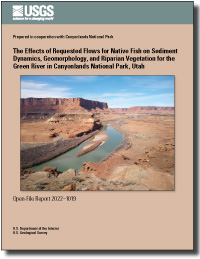The Effects of Requested Flows for Native Fish on Sediment Dynamics, Geomorphology, and Riparian Vegetation for the Green River in Canyonlands National Park, Utah
Links
- Document: Report (5 MB pdf)
- Download citation as: RIS | Dublin Core
Abstract
Releases of water from Flaming Gorge Dam together with climate-related variations in runoff determine the streamflow regime of the Green River, which affects the physical characteristics of the channel and riparian ecosystem of the Green River corridor in Canyonlands National Park. The dam has decreased peak streamflows and raised base streamflows, resulting in vegetation encroachment and channel narrowing and simplification, which could be detrimental to endangered fish habitats over time. Operations of Flaming Gorge Dam are in part determined by flow recommendations provided by the Upper Colorado River Basin Endangered Fish Recovery Program that are designed to benefit native fish and disadvantage nonnative fish. These recommendations alone may not be sufficient to prevent channel narrowing and simplification. Increases in base flows may contribute to channel narrowing and simplification by increasing the water available to riparian vegetation and reducing the water volume available for increasing peak-flow magnitude or duration This report describes how proposed revisions to these flow recommendations would affect the physical characteristics of the Green River corridor in Canyonlands National Park, with a focus on riparian vegetation and channel width.
Hydrologic conditions for the Green River downstream from Flaming Gorge Dam are classified by the U.S. Department of the Interior Bureau of Reclamation as dry, moderately dry, average, moderately wet, or wet. The flow recommendations for peak-flow magnitude and duration in wet years are consistent with geomorphic objectives and historical post-dam flows. In moderately wet years, although the recommended peaks may be sufficient to prevent narrowing over the short term, these peaks are lower than historical post-dam peak flows for moderately wet years and could therefore allow reduction in the occasional large peaks necessary to maintain sediment mobility and channel complexity. For average and drier years, the recommendations allow, but do not require, peak-flow magnitude and durations that are likely to achieve geomorphic objectives.
Suggested Citation
Grams, P.E., Friedman, J.M., Dean, D.J., and Topping, D.J., 2022, The effects of requested flows for native fish on sediment dynamics, geomorphology, and riparian vegetation for the Green River in Canyonlands National Park, Utah: U.S. Geological Survey Open-File Report 2022–1019, 20 p., https://doi.org/10.3133/ofr20221019.
ISSN: 2331-1258 (online)
Study Area
Table of Contents
- Acknowledgments
- Abstract
- Introduction
- Flow Variability, Channel Narrowing, and Riparian Vegetation
- Hydrology and Hydrologic Condition
- Assessment of flow recommendations
- Summary
- References Cited
- Appendix 1—Estimating Hydrologic Condition 1931–1992
| Publication type | Report |
|---|---|
| Publication Subtype | USGS Numbered Series |
| Title | The effects of requested flows for native fish on sediment dynamics, geomorphology, and riparian vegetation for the Green River in Canyonlands National Park, Utah |
| Series title | Open-File Report |
| Series number | 2022-1019 |
| DOI | 10.3133/ofr20221019 |
| Publication Date | March 08, 2022 |
| Year Published | 2022 |
| Language | English |
| Publisher | U.S. Geological Survey |
| Publisher location | Reston, VA |
| Contributing office(s) | Fort Collins Science Center, Southwest Biological Science Center |
| Description | vi, 20 p. |
| Country | United States |
| State | Utah |
| Other Geospatial | Green River, Canyonlands National Park |
| Online Only (Y/N) | Y |


